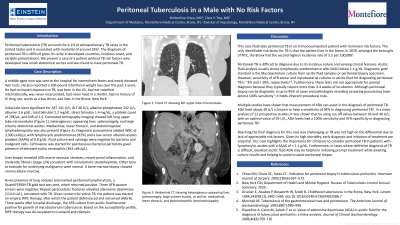Back


Poster Session E - Tuesday Afternoon
Category: Liver
E0538 - Peritoneal Tuberculosis in a Healthy Man With No Risk Factors for Tuberculosis
Tuesday, October 25, 2022
3:00 PM – 5:00 PM ET
Location: Crown Ballroom

Has Audio

Kimberline Chew, MD
Montefiore Medical Center
Bronx, NY
Presenting Author(s)
Kimberline Chew, MD, Clara Tow, MD
Montefiore Medical Center, Bronx, NY
Introduction: Peritoneal tuberculosis (TB) only accounts for 4.7% of all cases of extrapulmonary TB and is associated with significant mortality (50-60%). The diagnosis of peritoneal TB is difficult given its rarity in developed countries, insidious onset and variable presentations. We present a case of a patient with no risk factors for TB who was found to have peritoneal TB.
Case Description/Methods: A middle-aged male with history of fevers of unknown origin for one year was sent to the hospital by his primary care doctor for abnormal liver tests. He reported a 100 lbs weight loss over one year. He had no known exposure to TB, was born in and never travelled outside of the United States, never incarcerated or lived in a shelter, and works as a bus driver. Ultrasound revealed new cirrhotic-looking liver with ascites. CT imaging showed left upper lobe micronodules, and mediastinal, lower thoracic and abdominopelvic lymphadenopathy. Diagnostic paracentesis yielded WBC of 3,300 cells/uL, lymphocytic predominance (82%) and serum ascitic albumin gradient (SAAG) of 0.8 g/dL. Ascitic culture was negative, and ascitic cytology was negative for malignant cells. Ceftriaxone was started for presumed spontaneous bacterial peritonitis as met criteria despite inconsistent fluid studies. He continued to have fevers up to 102.7°F during the hospital stay. Given the persistent fevers, ascitic fluid lymphocytic predominance and lymphadenopathy, malignancy was highest on the differential. Given that lung micronodules were present, serum QuantiFERON was also ordered, which came back positive. Repeat paracentesis revealed ascitic adenosine deaminase activity (ADA) elevated at 114.4 U/L. He was started on quadruple therapy. Given initial high suspicion for malignancy, a bone marrow biopsy was performed which showed overall normocellular marrow with no evidence of lymphoma. A few days after starting therapy, fever was no longer noted and he remained afebrile post-discharge.
Discussion: This describes a unique case of peritoneal TB in a patient with no known risk factors. Reaching the final diagnosis for this case was challenging because TB was not the highest on the differential, although liver cirrhosis does have an increased risk of developing peritoneal TB. Given its high mortality, early diagnosis and initiation of treatment are essential. This highlights that it is important for clinicians to consider peritoneal TB in all patients with lymphocytic ascites with a SAAG of < 1.1 g/dL, regardless of risk factors.
Disclosures:
Kimberline Chew, MD, Clara Tow, MD. E0538 - Peritoneal Tuberculosis in a Healthy Man With No Risk Factors for Tuberculosis, ACG 2022 Annual Scientific Meeting Abstracts. Charlotte, NC: American College of Gastroenterology.
Montefiore Medical Center, Bronx, NY
Introduction: Peritoneal tuberculosis (TB) only accounts for 4.7% of all cases of extrapulmonary TB and is associated with significant mortality (50-60%). The diagnosis of peritoneal TB is difficult given its rarity in developed countries, insidious onset and variable presentations. We present a case of a patient with no risk factors for TB who was found to have peritoneal TB.
Case Description/Methods: A middle-aged male with history of fevers of unknown origin for one year was sent to the hospital by his primary care doctor for abnormal liver tests. He reported a 100 lbs weight loss over one year. He had no known exposure to TB, was born in and never travelled outside of the United States, never incarcerated or lived in a shelter, and works as a bus driver. Ultrasound revealed new cirrhotic-looking liver with ascites. CT imaging showed left upper lobe micronodules, and mediastinal, lower thoracic and abdominopelvic lymphadenopathy. Diagnostic paracentesis yielded WBC of 3,300 cells/uL, lymphocytic predominance (82%) and serum ascitic albumin gradient (SAAG) of 0.8 g/dL. Ascitic culture was negative, and ascitic cytology was negative for malignant cells. Ceftriaxone was started for presumed spontaneous bacterial peritonitis as met criteria despite inconsistent fluid studies. He continued to have fevers up to 102.7°F during the hospital stay. Given the persistent fevers, ascitic fluid lymphocytic predominance and lymphadenopathy, malignancy was highest on the differential. Given that lung micronodules were present, serum QuantiFERON was also ordered, which came back positive. Repeat paracentesis revealed ascitic adenosine deaminase activity (ADA) elevated at 114.4 U/L. He was started on quadruple therapy. Given initial high suspicion for malignancy, a bone marrow biopsy was performed which showed overall normocellular marrow with no evidence of lymphoma. A few days after starting therapy, fever was no longer noted and he remained afebrile post-discharge.
Discussion: This describes a unique case of peritoneal TB in a patient with no known risk factors. Reaching the final diagnosis for this case was challenging because TB was not the highest on the differential, although liver cirrhosis does have an increased risk of developing peritoneal TB. Given its high mortality, early diagnosis and initiation of treatment are essential. This highlights that it is important for clinicians to consider peritoneal TB in all patients with lymphocytic ascites with a SAAG of < 1.1 g/dL, regardless of risk factors.
Disclosures:
Kimberline Chew indicated no relevant financial relationships.
Clara Tow indicated no relevant financial relationships.
Kimberline Chew, MD, Clara Tow, MD. E0538 - Peritoneal Tuberculosis in a Healthy Man With No Risk Factors for Tuberculosis, ACG 2022 Annual Scientific Meeting Abstracts. Charlotte, NC: American College of Gastroenterology.
